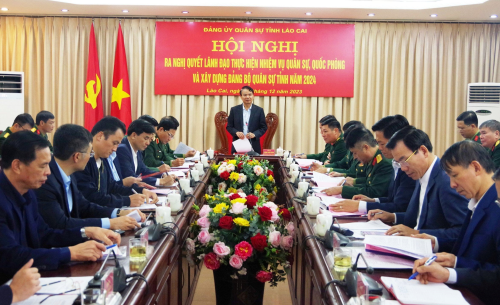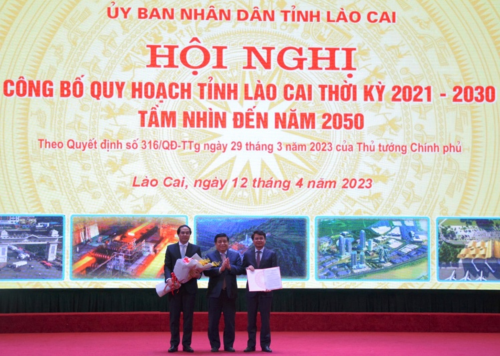Lao Cai province fosters socio-economic development in line with defence, security, and diplomacy strengthening
Thoroughly grasping the Party’s strategy on combining socio-economic development with defence, security, and diplomacy, the Party Organisation, authorities, armed forces, and ethnic people of Lao Cai province have been synchronously implementing measures to raise the effectiveness of combining all those central tasks, devoting effort to turn Lao Cai into a growth pole of the Northern Midlands and Mountainous Region.
 |
| Conference to release resolution on military-defence work and the building of Provincial Military Party Organisation in 2024 |
Located in the middle of Northwest and Northeast of Vietnam, Lao Cai province has a total area of nearly 6,400 km2 with a population of about 800,000; it shares a 182-km-long border with China; its border gates are in diverse positions and scales, thereby being favourable for the development of border trade and foreign relations. Moreover, Lao Cai is rich in natural resources, particularly in forest, water, and mineral resources; its road, railway, and waterway systems have been developed synchronously across the border. For that reason, Lao Cai has been holding an important position in the Kunming (China) – Lao Cai – Hanoi – Hai Phong – Quang Ninh corridor, acting as the bridge connecting Vietnam and ASEAN member states with China’s Southwest market and vice versa.
Being fully aware of the province’s strategic position, over the years, the Provincial Party Committee, Provincial People’s Council, and Provincial People’s Committee of Lao Cai have grasped and seriously implemented our Party and State’s resolutions and conclusions on combining socio-economic development with defence, security, diplomacy, and Fatherland protection in the new situation via proper measures, thus achieving a lot of positive results. More specifically, public awareness and a sense of responsibility towards this combination among cadres, sectors, organisations, localities, and citizens have been unceasingly raised. Such a combination has guaranteed comprehensiveness, synchronicity, and uniformity from plans to measures for implementation; it has been also relevant to the Northern Midlands and Mountainous Region’s master plan on socio-economic development, defence, and security. Regulations on coordination between sectors, the Military, and the Public Security Force have been gradually supplemented and completed in a close, scientific, highly feasible way. Staff work for the combination of those tasks has been effectively carried out by committees, sectors, and forces, especially the armed forces, thus providing considerable resources for defence and security.
In 2023, the province’s gross regional domestic product (GRDP) was 73,600 billion VND, increasing by 8.16% compared to 2022, ranking 4th out of 14 Northern Midlands and Mountainous Region provinces, placing 39th among 63 provinces and municipalities nationwide. In addition to socio-economic development, the province has attached importance to consolidating defence and security, building firm postures of all-people national defence and people’s security, and constructing strong defensive zones at all levels. Diplomatically, the province has worked with many delegations from agencies, localities, and enterprises both at home and abroad; at the same time, it has organised a lot of delegations visiting other countries to learn and attract investment from them.
 |
| Conference to announce Lao Cai provincial Master Planning in the 2021 – 2030 period, with a vision towards 2050 |
Bringing into play those good results, in the upcoming time, the Provincial Party Committee, Provincial People’s Council, and Provincial People’s Committee of Lao Cai will continue combining socio-economic development with defence, security, and diplomacy, striving to turn the province into a growth pole of the Northern Midlands and Mountainous Region and a hub for economic connection between Vietnam, ASEAN members, and Southwest China, ensuring defence, security, and diplomacy, protecting national sovereignty and border security, and maintaining peace, cooperation, and development, with a focus on several main solutions as follows.
First, enhancing propagation and education to raise public awareness and a sense of responsibility among cadres, sectors, organisations, localities, and people towards the task of combining socio-economic development with defence, security, and diplomacy. The Provincial Party Committee will focus on directing all-level party committees and authorities to render all people fully aware of the Party’s guidelines on defence, security, and diplomacy in the new situation, hostile forces’ plots and artifices as well as difficulties and implications caused by the market economy. The work of propagation and education will be comprehensive but centred on combining socio-economic development with defence, security, and diplomacy under the Resolution of the 13th National Party Congress, the Resolution of the 13th Party Central Committee’s 8th Plenum on the Strategy for Fatherland Protection in the New Situation, the Politburo’s Resolution 11-NQ/TW dated 10 January 2020 on orientations for the Northern Midlands and Mountainous Region’s socio-economic development, defence, and security towards 2030, with a vision towards 2045. Doing so will help remove the signs of overvaluing socio-economic development and disregarding defence, security, and diplomacy or vice versa. At the same time, well conducting the work of propagation and education will help handle a lack of drastic leadership, direction, and implementation, settle an imbalance of development between the fields, and promote the synergy of the political system, economic sectors, and all people to closely combine socio-economic development with defence, security, and diplomacy.
Second, raising the effectiveness of combining socio-economic development with defence, security, and diplomacy in the master plan and implementation process of each sector and locality. In the medium term, Lao Cai province’s master Planning for the 2021 – 2030 period, with a vision towards 2050 will continue to be carried out, with a focus on 3 breakthroughs, namely (1) completing synchronous, modern socio-economic infrastructures, particularly key traffic, large urban, border gate, and digital infrastructures, (2) developing and better applying science, technology, and innovation, stepping up digital transformation, (3) developing knowledge-based, hi-tech services, such as border gate services, tourism, education and training, and health care.
To effectively realise its master plan and the development plan for each sector, the province will create scientific, sustainable space for socio-economic development, with a focus on 1 motivation axis, 2 development poles, 3 economic zones, 4 growth pillars, and 5 central tasks. It will form an economic motivation axis along Red River with 2 development poles. The first pole will cover Lao Cai city, Bat Xat district, Sa Pa town, Bac Ha district, and part of Bao Thang district towards border gate economy, trade, tourism, industry, and agriculture as a direct connection with Southwest China. The second one will include Bao Yen and Van Ban districts towards urban development, tourism, agriculture and forestry as a bridge connecting provinces within the Northern Midland and Mountainous Region and Red River Delta with ASEAN member states. The province will have 3 economic zones, namely lowland, highland, and central ones. 4 economic growth pillars of the province will be border gate economy, processing and manufacturing industry, tourism and services, and agriculture, forestry and aquaculture. 5 central tasks as the foundation for the province’s development will include: perfecting institutions and policies, developing human resources and workforce, completing infrastructures, particularly traffic and digital infrastructures, developing agriculture and rural areas, preserving and promoting cultural identity of Lao Cai people.
As a border highland province, Lao Cai has a large area of defence land; its socio-economic development planning will definitely have great impacts on its defence-security tasks. Therefore, the province will direct its competent offices to guarantee a harmony between planning work and the building of military posture within defensive zones; key, public works must always serve the dual purposes of socio-economic development and defence-security strengthening when necessary. At the same time, the province will continue to maintain and develop the standing militia station at Ban Lau commune, Muong Khuong district as a role model and breakthrough in ensuring security and helping locals with poverty reduction via crop/animal husbandry, production, and afforestation. That is the concretisation of our Party and State’s viewpoints on combining socio-economic development with defence and security in the new period within Lao Cai province.
Bringing into play its advantages, the province will continue to organise diplomatic activities in all three pillars, namely Party diplomacy, State diplomacy, and people-to-people diplomacy under the 16th Provincial Party Committee’s Project No.11 on “expanding foreign relations, remaining proactive in international integration and cooperation, for the 2020 – 2025 period”. It will continue to maintain and practically develop its relations with traditional partners, such as Yunnan (China) and Nouvelle-Aquitaine (France). Taking advantage of support and guidance of the Ministry of Foreign Affairs, it will expand its cooperative relations with localities of Canada, Republic of Korea, Japan, and India as well as with international organisations and major financial institutions of the world. Doing so will enable the province to attract more investments in socio-economic development, culture, sports, and tourism, consolidate national defence and security, and firmly protect national sovereignty and border security.
Third, promoting the role of agencies, committees, sectors, and organisations in combining socio-economic development with defence, security, and diplomacy. In this regard, the province will direct its Military and Public Security agencies to actively cooperate with committees, departments, sectors, and organisations in suggesting measures to local party committees and authorities for seriously implementing Central resolutions and directives, ensuring that socio-economic development will be synchronously, uniformly, smoothly, effectively combined with defence, security, and diplomacy.
To that end, offices, units, departments, sectors, and organisations should continue to advise the Provincial Party Committee, the Provincial People’s Council, and the Provincial People’s Committee on completing mechanisms and policies as a favourable legal corridor for aligning socio-economic, cultural development with defence, security, and diplomacy. Military and Public Security agencies should play a core role in coordinating with departments, sectors, and committees to closely appraise projects and implement measures and mechanisms for information exchange right in the development of each construction and socio-economic, cultural development project, particularly in 5 border districts, 26 border communes and wards, projects within economic – defence zones, and foreign-invested projects. At the same time, they should give advice on organising and stabilising residential neighbourhoods in remote, isolated, extremely difficult, ethnic minority, border areas to guarantee human resources for production and protection of political security and social order and safety within the province.
Furthermore, offices and units should proactively adopt measures to mobilise external resources via international integration, investment promotion, and tourism promotion, while keeping raising the effectiveness of diplomacy, including defence diplomacy to facilitate the province’s socio-economic, cultural, tourism development. The Provincial Military Command should closely cooperate with departments, sectors, and localities to advise the Provincial Party Committee and the Provincial People’s Committee on developing types of potential within defensive zones and tapping all possible resources to build military works, with priority given to combat and rear bases in an inter-connected, solid, in-depth fashion. Measures should be intensified to closely manage and properly use national defence land; a master plan on the use of national defence land should be developed and integrated into each infrastructural development plan to ensure a harmonious combination of socio-economic development, defence, security, and diplomacy and make contributions to the whole country’s successful fulfilment of the two strategic tasks of Fatherland construction and protection in the new situation.
DANG XUAN PHONG
Member of the Party Central Committee
Secretary of the Provincial Party Committee